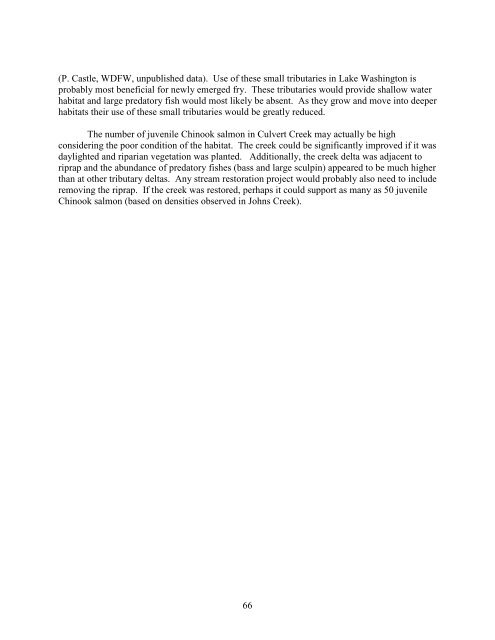Nearshore Habitat Use by Juvenile Chinook Salmon in Lentic ...
Nearshore Habitat Use by Juvenile Chinook Salmon in Lentic ...
Nearshore Habitat Use by Juvenile Chinook Salmon in Lentic ...
Create successful ePaper yourself
Turn your PDF publications into a flip-book with our unique Google optimized e-Paper software.
(P. Castle, WDFW, unpublished data). <strong>Use</strong> of these small tributaries <strong>in</strong> Lake Wash<strong>in</strong>gton is<br />
probably most beneficial for newly emerged fry. These tributaries would provide shallow water<br />
habitat and large predatory fish would most likely be absent. As they grow and move <strong>in</strong>to deeper<br />
habitats their use of these small tributaries would be greatly reduced.<br />
The number of juvenile <strong>Ch<strong>in</strong>ook</strong> salmon <strong>in</strong> Culvert Creek may actually be high<br />
consider<strong>in</strong>g the poor condition of the habitat. The creek could be significantly improved if it was<br />
daylighted and riparian vegetation was planted. Additionally, the creek delta was adjacent to<br />
riprap and the abundance of predatory fishes (bass and large sculp<strong>in</strong>) appeared to be much higher<br />
than at other tributary deltas. Any stream restoration project would probably also need to <strong>in</strong>clude<br />
remov<strong>in</strong>g the riprap. If the creek was restored, perhaps it could support as many as 50 juvenile<br />
<strong>Ch<strong>in</strong>ook</strong> salmon (based on densities observed <strong>in</strong> Johns Creek).<br />
66
















